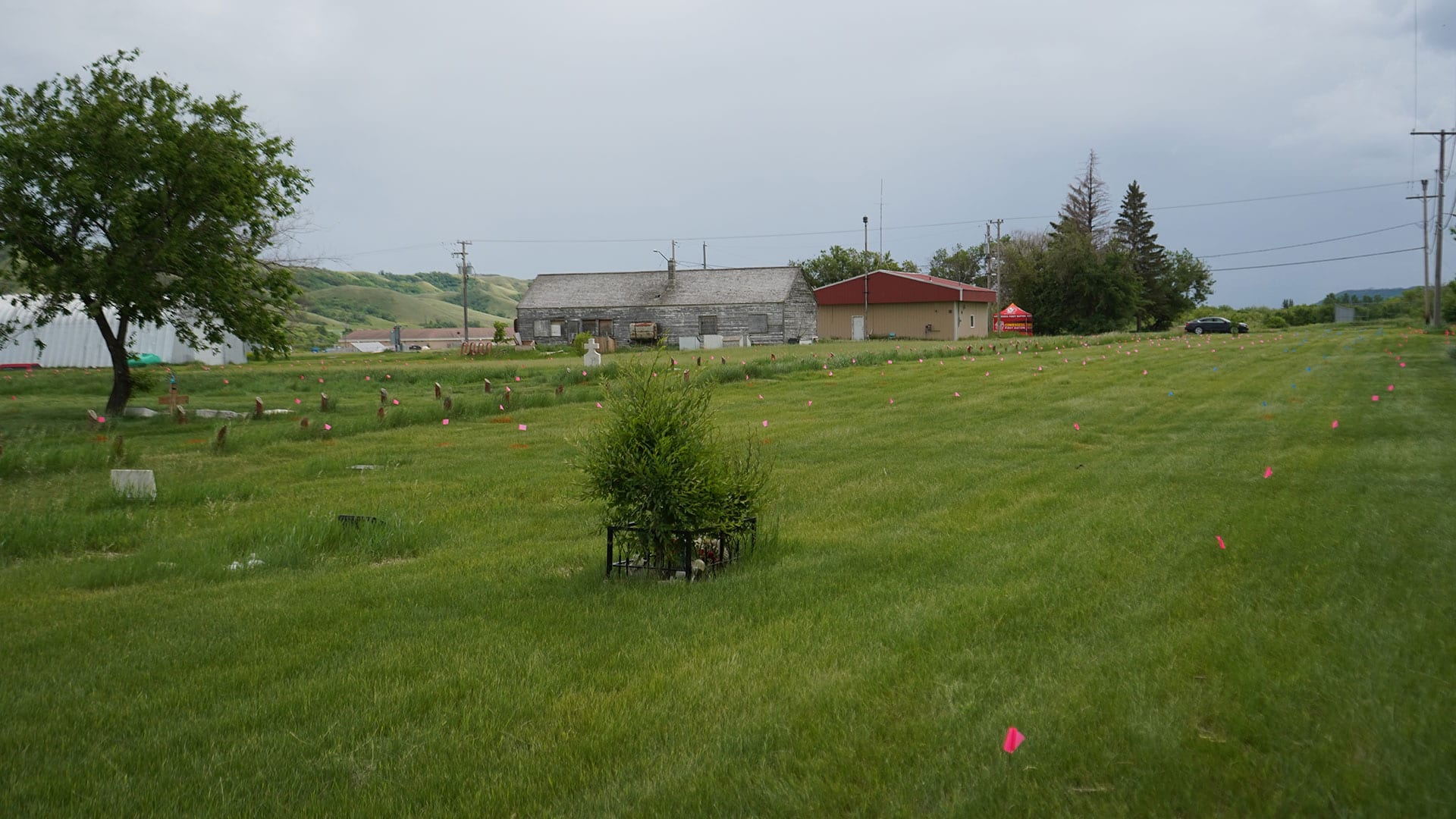The Indian Residential Schools Resolution Health Support Program has a hotline to help residential school survivors and their relatives suffering from trauma invoked by past abuse. The number is 1-866-925-4419.
The Cowessess First Nation in southern Saskatchewan says it has located 751 unmarked graves in its community cemetery.
Chief Cadmus Delorme says the graves belong to children connected to the Marieval Indian Residential School that operated in the community from 1899 to 1997.
“This could be triggering to many,” Delorme told a virtual press conference Thursday morning attended by local, national and international news reporters.
“We are talking about unmarked graves. We’re not talking about a mass gravesite.”
Delorme said the graves were discovered using ground-penetrating radar between June 2 and June 23.

He said each grave – some only one metre by one metre apart – was now marked with a small flag.
“Of the 751 hits, the machine has a 10 to 15 per cent error percentage,” Delorme explained. “So we will only go by the hits that we have of 751. But we do know there’s at least 600 (graves).”
He said it is unknown if all of the dead are children.
Cowessess, located 160 km east of Regina, is the second First Nation in western Canada to report the discovery of a residential school burial site using ground-penetrating radar.
On May 27, Tk’emlúps te Secwépemc First Nation in B.C., said it found 215 individual graves of children from the former residential school in Kamloops, British Columbia.
Roman Catholic Church
Both schools were operated by the Roman Catholic Church. They were among a century-long network of 134 residential schools across Canada established and funded by the federal government and run by religious groups as a way to assimilate Indigenous Peoples.
Cowessess’ Elder Florence Sparvier, 80, said the nuns at the school were “very mean” to children like her, her mother and grandmother.
“We had to learn how to be Roman Catholic. We couldn’t say our own little blessings the way we said it at home,” she told the news conference.
“They were putting us down as a people. So we learned to not like who we were.”
In Cowessess, the graveyard was operated by the church until 1970, when it became a community cemetery taken over by the First Nation.

During the handover, Delorme said many of the headstones were allegedly plowed under or destroyed by the church.
“We always knew that there was graves here,” he added.
“The recent story of the Kamloops Residential School has triggered many in this country. And we knew this was going to trigger as well.”
The chief said he’d spoken with Prime Minister Justin Trudeau, Indigenous Services Minister Marc Miller and Crown-Indigenous Relations Minister Carolyn Bennett prior to Thursday’s official announcement.
APTN News has reached out to the Prime Minister’s Office for an interview.

Delorme said he’d also spoken with the Roman Catholic Archdiocese of the region, whom he was confident would share burial records with the 4,400 members of his Nehiyawak-Anishinaabe community.
He noted that “removing headstones is a crime in this country” and there may be future criminal or legal action as a result.
“We are treating this like a crime scene, at the moment.”
Delorme said children forced to attend the school came from central and southeastern Saskatchewan and southwestern Manitoba.
“The Roman Catholic residential school has impacted us intensely,” he added, but “we never, ever swayed away from who we are…We ask that you stand by us as we heal and we get stronger.
“We are not asking for pity,” he added, “but we are asking for understanding. We need time to heal and this country must stand by us.”

Chief Bobby Cameron of the Federation of Sovereign Indigenous Nations in Saskatchewan said the Cowessess discovery would focus unflattering international attention on Canada.
“This was a crime against humanity; an assault on First Nation people,” Cameron said.
“We are proud people. The only crime we ever committed as children was being born Indigenous.”
Cameron, whose organization represents the 74 First Nations in Saskatchewan, said ground searches would be done wherever governments institutionalized Indigenous Peoples.
“We are seeing the results of the genocide that Canada committed here,” he said. “Genocide on our treaty land. We will find more bodies and we will not stop until we find all of our children.
“We will do a search of every Indian residential school site and we won’t stop there,” Cameron added.
“We will also search all of the [tuberculosis] sanatoriums, Indian hospitals and all of the sites where our people were taken and abused, tortured, neglected and murdered.”
‘Concentration camps’
Cameron said residential schools were “concentration camps” and the country had some explaining to do.
“Canada will be known as a nation who tried to exterminate the First Nations. Now, we have evidence.”
Delorme said the search for unmarked graves would continue in two parts: Phase 1, which he said covered 44,000 sq. metres, would include identifying the 751 dead and marking their final resting place. Phase 2 would include searching other sites in the community over several years and erecting a monument.
The federal and many provincial governments have announced funds to aid such searches.
“It’s going to hurt in the coming months because the more we put names to them the more it is going to reopen some of the pains that many endured at the Marievale Residential School,” said Delorme, noting the burial ground will be preserved as a place of reflection and healing.
“The gravesite is there and it’s real. And if you were to see it, there are 751 flags when you look at it.”









